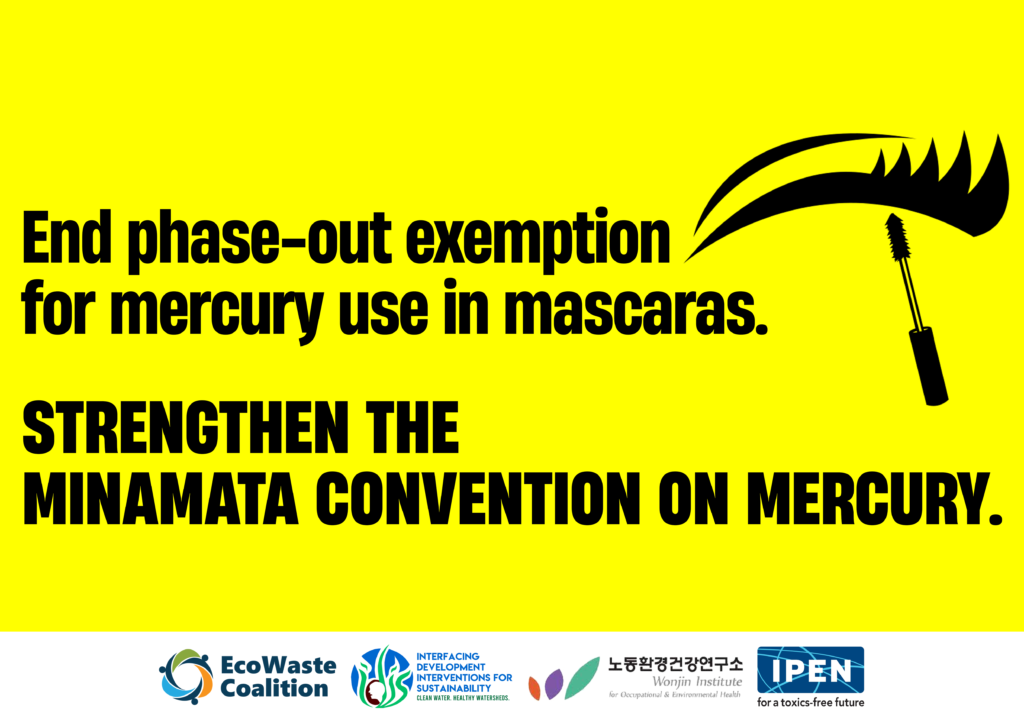Text by Henrylito D. Tacio
Mercury is a liquid silver metal that has found many uses in industry. The Haribon Foundation, an environmental group, says that in the Philippines, mercury is primarily used for processing gold, lead, and zinc.
Mercury is also used in making batteries, electrical materials, chlorine, and caustic soda, paint, medicine, paper, dental amalgam, and pesticides.
Unknowingly, mercury is likewise utilized as an ingredient in beauty products such as soaps, lotions, hair straighteners, skin bleaches, and many more.
Since mercury is a hazardous chemical, environmental health organizations in the country are asking governments across the world to end a partial exemption on mercury use for eye area cosmetics such as mascaras under the Minamata Convention on Mercury.
As it stands, only cosmetics such as skin lightening creams and soaps with mercury content above one part per million (ppm) have been targeted for global phase-out in 2020 under the mercury treaty.
Partially exempted from the complete phase-out in 2020 are eye area cosmetics, where mercury is used as a preservative, and no effective and safe substitute preservatives are available.
“The data on mercury content of mascaras sold in the Philippines and other countries provide a good basis to rescind the phase-out exemption for such mercury-added products under the Minamata Convention. We will urge our government to take note of our findings and seek the necessary treaty amendment,” said Aileen Lucero, the national coordinator of EcoWaste Coalition.
Atty. Mark Peñalver, executive director of the Davao-based Interfacing Development Interventions for Sustainability (IDIS), noted that “removing the treaty exemption will make intentionally added mercury in eye area cosmetics a thing of the past,” emphasizing “it’s high time for all cosmetics to go mercury-free.”
Dr. Won Kim, director of Wonjin Institute for Occupational and Environmental Health, added: “It’s a very frustrating situation for experts to detect hazardous chemicals, such as mercury, in cosmetics. Toxic chemicals used in cosmetics must be substituted with safer alternatives.”
For the 20 samples collected by the EcoWaste Coalition and IDIS, the concentrations of mercury detected range from 0.0021 to 0.0392 ppm, way below the one ppm maximum limit for mercury in cosmetics under the Minamata Convention on Mercury and pertinent regulations like the ASEAN Cosmetic Directive.
Humans have had a long history with mercury, and it is well known, for instance, that mercury was used in the gold plating of the Great Buddha in Nara and in the Edo period in medicine and facial powder. Furthermore, Japanese place names such as Niu indicate areas where mercury was produced and used long ago.
Mercury has long been known to be toxic; the phrase “mad as a hatter” refers to the 19th-century occupational disease that resulted from prolonged contact with the mercury used in the manufacture of felt hats. Some workers today, especially laboratory technicians, nurses, and machine operators, continue to be exposed to mercury on the job.
Mercury is classified into inorganic mercury and organic mercury. Metallic mercury, which is a type of inorganic mercury, is used in familiar items such as fluorescent lights, batteries, and thermometers.
The methyl mercury which caused Minamata disease is a type of organic mercury. It is a white powdery substance and smells like the sulfur in a hot spring. It is easily absorbed from the stomach into the blood and carried to the liver and kidney, and then the brain and even the fetus, where it is absorbed and concentrated and causes great damage to the human body.
Minamata disease was called such since it was discovered in the communities near Minamata Bay in Japan. It happened in the late 1950s.

Minamata disease is caused by eating large quantities of fish and shellfish polluted by methyl mercury in factory wastewater. It is not a contagious disease transmitted through air or food, and it is not inherited.
In Minamata disease, the mercury that enters the body mainly attacks the central nervous system, including the brain, and causes various symptoms including numbness and unsteadiness in the legs and hands, tiredness, ringing in the ears, narrowing of the field of vision, loss of hearing, slurred speech, and awkward movements.
Historical records showed that some early severe victims of Minamata disease went insane, became unconscious, and died within a month of the onset of the disease.
Once mercury is released into rivers, lakes, and other aquatic environments, bacteria can transform the mercury into its organic form – highly toxic methylmercury. Mercury, in this form, can be absorbed by creatures living in the water. It increases in concentration (so-called “biomagnifying”) as it moves up the food chain to fish and humans.
“All humans are exposed to some level of mercury,” says the Geneva-based World Health Organization. “Most people are exposed to low levels of mercury, often through chronic exposure (continuous or intermittent long-term contact).
“However, some people are exposed to high levels of mercury, including acute exposure (occurring over a short period of time, often less than a day). An example of acute exposure would be mercury exposure due to an industrial accident.”

